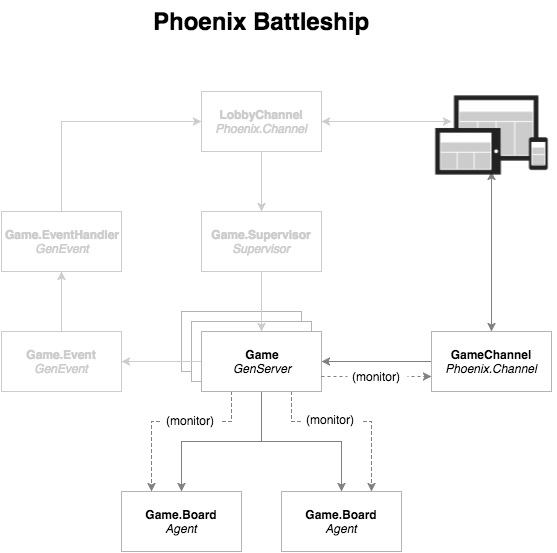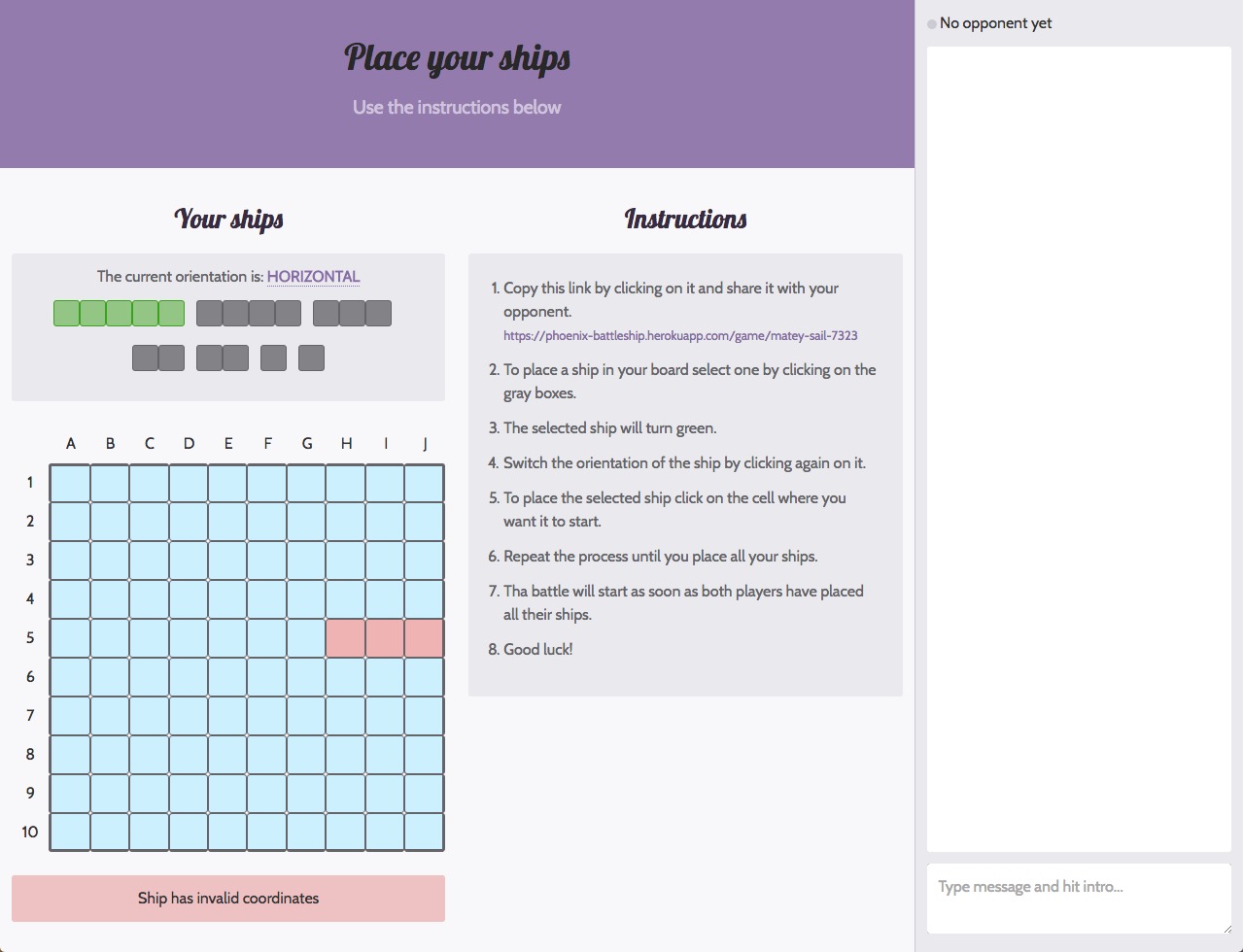This post belongs to the Building Phoenix Battleship series.
Placing ships on the board's grid
In the last part of these series, we covered everything related to the game setup, joining an existing game, creating players boards and returning the game state to the players. Now it is time to start with the fun part, and let the players place their corresponding so they can begin the battle.

The BoardChannel
When a player joins an existing game, and his board Agent process is created and ready, the player can start placing his ships.
Any ship can be selected by clicking on it in the ship selector. Clicking it twice will change its orientation
from horizontal to vertical. Once selected, the player has to click on a cell from his game board to place it.
Once a cell is clicked (selecting it as the starting position of the ship), a new message is sent to the GameChannel to place
it in the player's Board process.
# web/channels/game_channel.ex
defmodule Battleship.GameChannel do
use Phoenix.Channel
...
def handle_in("game:place_ship", %{"ship" => ship}, socket) do
player_id = socket.assigns.player_id
game_id = socket.assigns.game_id
ship = %Ship{
x: ship["x"],
y: ship["y"],
size: ship["size"],
orientation: String.to_atom(ship["orientation"])
}
case Board.add_ship(player_id, ship) do
{:ok, _} ->
game = Game.get_data(game_id, player_id)
board = Board.get_opponents_data(player_id)
broadcast(socket, "game:player:#{Game.get_opponents_id(game, player_id)}:opponents_board_changed", %{board: board})
{:reply, {:ok, %{game: game}}, socket}
{:error, reason} ->
{:reply, {:error, %{reason: reason}}, socket}
end
end
...
endAlong with the game:place_ship message, the client is sending the ship's data, which consists of its starting cell coordinates (represented
by x and y), its size and orientation. Using this data, we create a new Ship struct and call the Board.add_ship(player_id, ship) function, which
will place the ship on the corresponding board. If the ship is placed correctly, we get the new game state for the current player, so it is
returned to the client. We also need to tell the opponent that the player has placed a new ship, so we get the public board data
(hiding the ships placements), and broadcast it to the opponents client. On the other hand, it there is an error in the ship placement, we notify it to the player.
The Ship module
Before continuing with the Board.add_ship/2 implementation, let's define the Ship struct:
# web/models/ship.ex
defmodule Battleship.Ship do
defstruct [
x: 0,
y: 0,
size: 0,
orientation: :vertical,
coordinates: %{}
]
def coordinates(%{x: x, y: y, size: size, orientation: :vertical}) do
Enum.map(y..(y + (size - 1)), &coordinate_key(&1, x))
end
def coordinates(%{x: x, y: y, size: size, orientation: :horizontal}) do
Enum.map((x..x + (size - 1)), &coordinate_key(y, &1))
end
defp coordinate_key(y, x), do: Enum.join([y, x], "")
endIt consists of the previously commented x, y, size and orientation keys, and a coordinates map, which stores any hit
on any of its coordinates. The coordinates/1 function returns a list of coordinates representing the ship, depending on its
orientation and size.
The Board module
Now that the Ship module is defined, we can continue implementing the missing Board functionality:
# lib/battleship/game/board.ex
defmodule Battleship.Game.Board do
...
@ships_sizes [5, 4, 3, 2, 2, 1, 1]
@size 10
@orientations [:horizontal, :vertical]
...
def add_ship(_player_id, %Ship{size: size}) when not size in @ships_sizes, do: {:error, "Invalid size"}
def add_ship(_player_id, %Ship{x: x}) when x > (@size - 1) or x < 0, do: {:error, "Invalid position"}
def add_ship(_player_id, %Ship{y: y}) when y > (@size - 1) or y < 0, do: {:error, "Invalid position"}
def add_ship(_player_id, %Ship{orientation: orientation}) when not orientation in @orientations, do: {:error, "Invalid orientation"}
def add_ship(player_id, ship) do
board = Agent.get(ref(player_id), &(&1))
cond do
board.ready ->
{:error, "All ships are placed"}
ship_already_placed?(board, ship) ->
{:error, "Ship already added"}
ship_with_invalid_bounds?(ship) || ship_with_invalid_coordinates?(board, ship) ->
{:error, "Ship has invalid coordinates"}
true ->
new_board = board
|> add_ship_to_grid(ship)
|> set_hit_points
|> set_is_ready
Agent.update(ref(player_id), fn(_) -> new_board end)
{:ok, new_board}
end
end
...
# Checks if a similar ship has been already placed
defp ship_already_placed?(%__MODULE__{ships: ships}, %Ship{size: size}) do
permited_amount = Enum.count(@ships_sizes, &(&1 == size))
Enum.count(ships, &(&1.size == size and ship_placed?(&1))) == permited_amount
end
# Checks if the ship is inside the boards boundaries
defp ship_with_invalid_bounds?(%Ship{orientation: :horizontal} = ship) do
ship.x + ship.size > @size
end
defp ship_with_invalid_bounds?(%Ship{orientation: :vertical} = ship) do
ship.y + ship.size > @size
end
# Checks is the ship is overlaps an exisiting one
defp ship_with_invalid_coordinates?(board, ship) do
ship
|> Ship.coordinates
|> Enum.map(&(board.grid[&1] == @grid_value_ship))
|> Enum.any?(&(&1 == true))
end
...
end
Thanks to Elixir's pattern matching and guard clauses, we can add some basic and straightforward validation.
Therefore, the first four add_ship function clauses validate size, position and orientation against the
predefined configuration of the module, returning any possible {:error, reason}. In case these first validations succeed,
we need to make more complex ones, so in the last clause we retrieve the board's state from the Agent process and check
the following:
- If the board is ready, we return an error notifying that all ships have been already placed.
- If the player is trying to place a ship twice, we also need to return an error.
- Same if the ship is placed out of bounds or overlapping a previously added ship.
If none of these happen, then we can add the ship to the grid, set the current hit points and check if the board is ready to start the battle:
# lib/battleship/game/board.ex
defmodule Battleship.Game.Board do
...
def add_ship(player_id, ship) do
board = Agent.get(ref(player_id), &(&1))
cond do
...
true ->
new_board = board
|> add_ship_to_grid(ship)
|> set_hit_points
|> set_is_ready
Agent.update(ref(player_id), fn(_) -> new_board end)
{:ok, new_board}
end
end
...
defp set_hit_points(board), do: %{board | hit_points: Enum.reduce(board.ships, 0, &(&1.size + &2))}
defp set_is_ready(board), do: %{board | ready: Enum.all?(board.ships, &ship_placed?(&1))}
defp ship_placed?(ship), do: length(Map.keys(ship.coordinates)) != 0
endNote that board's total hit points are the sum of all its placed ships sizes, and it is ready when all ships have been placed.
Finally, we have to update the board's process state with the new modifications by using the Agent.update/1 function,
and also return it in a tuple along with the :ok atom.
Enough for now :) In the next part we are going to cover the functionality related to shooting, handling possible errors and what to do when one of the players leaves the game in the middle of the battle. Meanwhile, feel free to take a look to the final (but still in progress, though) source code or challenge a friend to a battleship game.
Happy coding!


